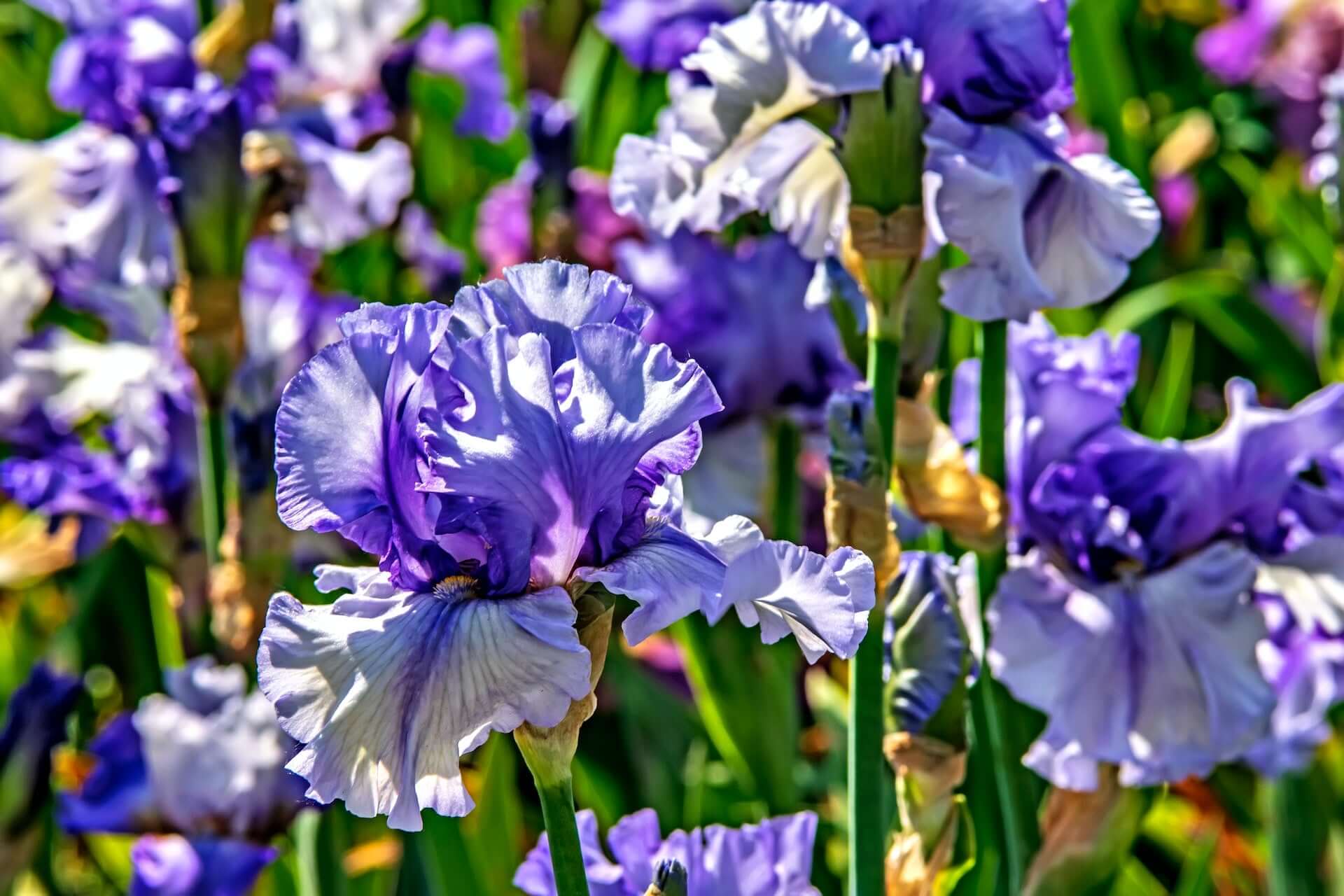Step-by-Step Guide for Creating an Iris Garden

Share
How to Create an Iris Garden
Irises have a unique and distinct look. When in bloom, the iris has breathtaking flowers. If you have an adoration for Irises and want to create an Iris garden of your own, keep reading.
In this article, you will learn about ideal iris growing conditions, how to design an iris garden, and where to buy your irises.
All about the Iris:
Iris was named after the Greek goddess of the rainbow, 'Iris'. It is much-loved and is one of the longest used botanical plants.
Growing irises has its benefits. They are hardy and reliable, plus they are easy to grow. They can tolerate a range of soils. Additionally, they are deer-resistant and drought-tolerant.
When in bloom, irises attract pollinators like butterflies and hummingbirds. Irises look beautiful in bouquets.
There are hundreds of types of irises to choose from. In fact, it's estimated that there are around 300 different species and varieties of the iris. Unlike most plants, the best time to divide is in summer when irises are dormant.
Best Conditions for Irises
Irises thrive in organic, free-draining soils. Different species have slightly varying needs, but overall they prefer slightly acidic soils. Many irises can tolerate a range of soils including boggy and clay soils.
Most irises prefer full sun, but there are some that tolerate shade. It is important that rhizome-forming irises receive plenty of sun. Their rhizome needs to be slightly above the soil level so it can reach its fullest potential.
How to Design an Iris Garden
Choosing Your Iris Garden Location
The best spot for an iris garden depends on what kind of irises you plan on putting in the garden. However, most irises will do well in sunny spots.
If you have boggy soil and clay soil, irises can thrive. This is unique because both conditions are difficult to plant in.
Pick a spot where you will be able to enjoy your plants to the fullest. Planting them by a common-room window or in view from the bedroom are worthy considerations.
Keep in mind that an iris garden can be any size. Whether you have a tiny area or plan to fill your backyard, an iris garden will be beautiful no matter the scale.
Iris Garden Design
It is recommended that you plan out where you want to place plants in the iris garden. Here are a few thoughts to consider when creating your design:
- How much sun does this space receive a day?
- What is the soil like? Is it acidic or alkaline?
- Will I be able to divide irises as needed throughout the years?
- How many plants will I be able to take care of?
- Am I going to do any companion or succession planting?
Keep in mind that irises bloom gloriously for a short period of time. If you prefer to have an iris-only garden, then no need to worry about other plants.
If you want year-round interest, but still want your irises to be the star of the show, you can do that, too. There are plenty of plants that pair well with irises.
Iris Garden Plants:
There are plenty of irises to choose from. Here at Wholesale Nursery Co., we offer a variety of irises that range in growing preferences Here is a list of our irises (while supplies last):
Bearded Iris
The Siberian iris would make a great iris garden plant because of its dramatic, folded blooms. It's vibrant purple tone stands out against its sword-shaped foliage. It stands tall and easy to grow and propagate to create even more plants!
Zones: 3 to 9Sun exposure: Full sun Mature height: up to 3½ feet tall Water: Average to moist
Dwarf Crested Iris
The dwarf crested iris does best in part shade (or full shade) and makes for a good container plant. It can be planted as a groundcover plant or in the front of iris gardens. It can be grown in organic, rich, and moist soils. It can be planted in full sun, only if its planted in boggy soil. It reproduces by rhizome and is easy to divide.
Zones: 3 to 9Sun exposure: Full sun to part shadeMature height: up to 10 inchesWater: Average
Check out the Dwarf Crested Iris product page here
Siberian Iris
The Siberian iris tolerates moist soils wells. It has striking purple flowers with yellow origins. It is enjoyed by pollinators and is another rhizome-forming plant. It can be planted in fall and propagated in summer after it blooms. This is true for most irises.
Zones: 3 to 9Sun exposure: Full sunMature height: up to 3 feetWater: Average to wet
Check out the Siberian Iris product page here
Blue Flag Iris
The blue flag iris can be grow average to wet soil. It can even be planted in standing water and in constantly moist soils or near water features (without chlorine). It thrives in full sun and can tolerate some amounts of shade. The blue flag iris adds flecks of purple in the iris garden and is easy to grow.
Zones: 3 to 9Sun exposure: Full sunMature height: up to 3 feetWater: Average
Check out the Blue Flag Iris product page here
How to plant an Iris
Planting irises is easy, but it is a bit different than planting other perennial plants. Here is a step-by-step guide on planting irises in your iris garden:
- Wear gloves when planting irises
- Dig a shallow hole
- Place roots of iris in hole, making sure to spread them out
- Cover roots with soil
- Leave the top third of the rhizome above the soil level (the sun needs to shine on this part of the plant so it can grow successfully)
- Mulch around the plant, but do not cover the exposed rhizome
Iris Aftercare and Division
Irises are relatively low maintenance, but do need some care after blooming. If you notice that your iris is suffering, check the soil conditions. Most irises like having 'wet feet' and can't tolerate periods of excess drought. If your area is prone to drought, move your irises into a spot with more shade.
Here are some aftercare tips to keep your iris garden in great shape:
- Air circulation is key to growing irises successfully, make sure they have room to 'breathe'
- After blooming, the foliage off in a fan shape three inches above the rhizome
- Mulch with one inch of bark or compost in autumn to add nutrition to the soil
- Dig and divide in summer after blooming when the iris is dormant
- Avoid dividing in winter or early spring, this could result in smaller blooms that season
Why Plant an Iris Garden?
Planting an iris garden should serve one major purpose: to make you and your loved ones happy. If irises give you joy, there is no reason to hold back or settle on a garden that you don't 100% love. Irises are well worth the effort it takes to grow them and the patience it takes for them to bloom!
We hope this article gave you the motivation to grow your own iris garden or at least try irises in your current garden! Let us know if you have any questions about irises or growing an iris garden.
